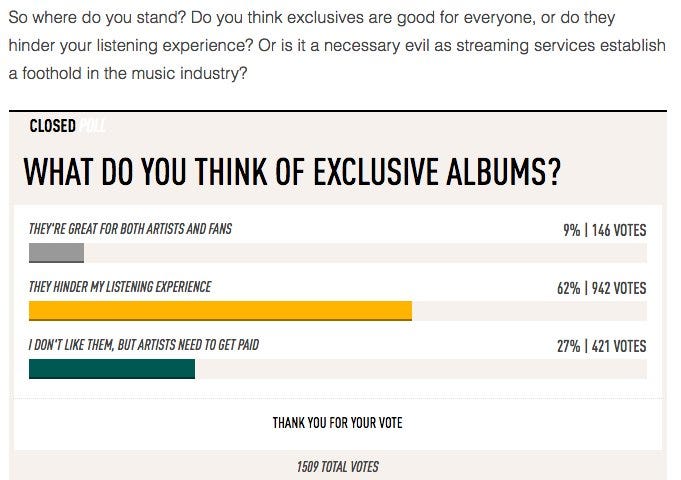Although the recent wave of much-loathed platform-exclusive releases seems to be coming to an end, the question still remains of what will come next for streaming platforms and consumers.
_____________________________
Guest Post by Cortney Harding on Medium
The Verge recently ran a poll of readers, asking them about streaming exclusives in the wake of Lucian Grainge of Universal’s directive to stop the practice. Customer sentiment could not be more clear — the vast majority of those who responded disliked streaming exclusives. The writing finally seems to be on the wall for the practice, which allowed artists and labels to cash in at the expense of giving fans access to new content. The news is great for listeners, but it poses a difficult question for streaming services: if their one main form of differentiation and customer acquisition is gone, now what do they do to set themselves apart and onboard new users?
The biggest losers in all of this seem to be Apple Music and Tidal. Spotify has managed to grow while remaining largely out of the exclusives business, although reports are circulating that it plans to window some releases for paying customers only. Apple Music doubled down on exclusives, offering a number of them recently, including the Frank Ocean album that got more coverage for its endless, artsy rollout than it has for the actual music (which is pretty outstanding).
The upside for Apple is that is still has strong name recognition and the backing of one of the most profitable companies on the planet, although that only gets you so far. Tidal, which was rumored to be a potential acquisition target for Apple earlier this summer, is in far worse shape — its whole premise was built on its artist connections and the promise of content you couldn’t get anywhere else (except pirate sites, of course). But with Spotify still standing atop the mountain, both services need to figure out a way to differentiate their offerings.
Both Apple and Tidal have started poking around in the video space, a smart move given people’s willingness to subscribe to multiple video services but not multiple music services. Apple recently bought Carpool Karaoke, and Tidal announced original programming late last year. Unfortunately, not much has happened since the announcement in terms of actually releasing content, and Apple’s version of Carpool Karaoke has yet to announce a host (James Corden will not host, and will continue to run the segment on his own show). Spotify has also released original video content, although to mixed reviews, with a documentary about Metallica’s early years getting more positive press, while “How EDM Changed the World” didn’t perform as well.
To attract users, all the services will need to step up their games considerably. This won’t be cheap, as producing original content can be quite pricey, especially when they need to produce and launch multiple shows to keep people engaged. Netflix seems to launch a new series of some sort every week, and people are fast becoming used to that level of new content, so in order to get folks to shell out, they need to be releasing a lot of video. Virtual reality content is another place where streaming services could wisely invest — that content is more immersive and cutting edge than regular video, so fans might not demand as much of it right away. It would be easy for Spotify to start releasing the concerts it holds in its offices in 360 video, for example, and it’s surprising it hasn’t yet done so.
Curation also remains a viable path to differentiation, and Spotify seems to be taking the lead in that respect. Its Discover Weekly playlists have generated rave reviews, and it recently launched a Friday playlist of curated new releases that has been gaining traction as well. But Spotify has struggled to engage fans beyond the discovery step, something that might not be as big a deal for the company but is a problem for artists. As consumption shifts towards the playlist model, music fades more into the background, and it becomes much harder for fans to keep track of music they heard and liked and follow up with the artists.
One thing a streaming service could do is further integrate social features that allow fans to follow the artists on Twitter or like them on Facebook easily. Now, the process is clunky and requires many steps, and lots of fans simply forget. Spotify also needs to create more opportunities for discovery outside of the app, like learning a user’s tastes and providing live music recommendations seamlessly, or allowing users to subscribe to a curated feed of local shows and perhaps even secure tickets set aside for Spotify subscribers. A huge frustration of mine is when I find an artist I like on a playlist and discover they played in my city last week — for a busy thirty-something professional who still wants to be connected but doesn’t have the time to spend keeping up with show listings, something that allowed me to to seamlessly get tickets to the hottest shows would be a huge benefit.
Despite the crowded field, more players are entering the streaming space — Deezer finally launched in the U.S. to almost no fanfare and then promptly lost its CEO to a vape company, and Amazon is rumored to be launching a much more robust streaming service in the fall. In order for any of the services to survive, they need to figure out a way to stand out from the rest; otherwise users will just pick at random. The death of exclusive release is a great thing for fans, but it will require some creative thinking from streaming services. Luckily, if that thinking leads to more great content, everyone will benefit.
